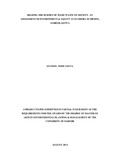| dc.description.abstract | While all members of society often appreciate and enjoy environmental improvements of civilization, a growing body of evidence reveals that environmental problems of human civilization are not borne equally by various segments of society. Quite more often than not, people with low income tend to bear greater environmental and health risks of civilization than affluent people. For example, in most cities, low-income settlements play host to most waste dumping sites while affluent communities enjoy some of the best waste management, health, water and sanitation facilities even though affluent people (by virtue of their consumption habits) generate more waste. The general objective of this study was to assess environmental equity among urban population. The specific objectives of this study were to identify common diseases attributable to the Dandora dumpsite prevalent among communities living in its neighbourhood, establish whether these diseases were suffered equally among these communities, examine if there factors that could have made part of these communities more vulnerable to health risks, and determine if there is a relationship between socioeconomic status and exposure to health hazards. The hypotheses which were tested included: there is no significant relationship between the respondent‟s location of residency, waste disposal mechanism, source of water and frequency of disease occurrence, there is no significant relationship between the respondent‟s nature of employment, household income, level of education and frequency of disease occurrence and there is no significant difference between respondent‟s length of stay in the current location and frequency of disease occurrence.
The study used 65 households sample drawn from 73,519 housholds in the three communities adjacent to the dumpsite. The sample was obtained through both random and non-random sampling techniques. To bring out clearly issue of environmental inequities, the study collected data from a health clinic located in middle class population to compare diseases prevalence in this populace. The study collected data using questionnaires, interviews and observations and analyzed the data using regression and chi-square tests. Charts and other relevant graphics were used to visualize the data. Regression analysis and chi-square analysis were used to test for relationships and differences in the data respectively. The analysis revealed that the socially and economically deprived persons suffer more from the consequencies of mismanaged waste even when they are in the same neighbourhood with those better off. They are also more vulnerable to health risks thus a relationship was drawn between socioeconomic status and environmental equity issues. Towards achieving environmental equity, the study recommends that the low socioeconomic persons be empowered to become the solution to the problem. There is need also to formulate environment policies geared towards alleviating the burden borne by this category of persons. | en_US |

